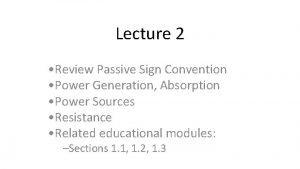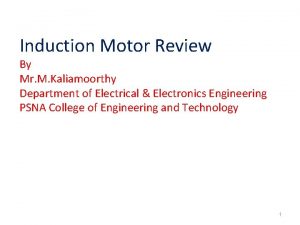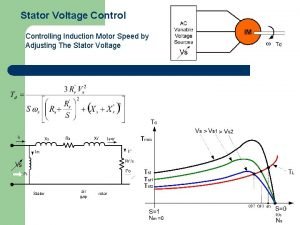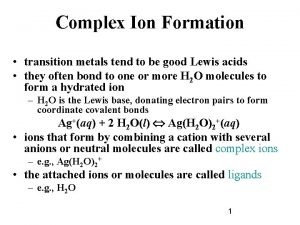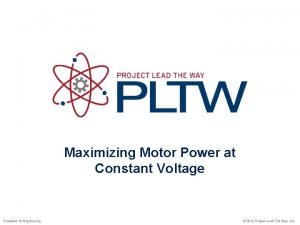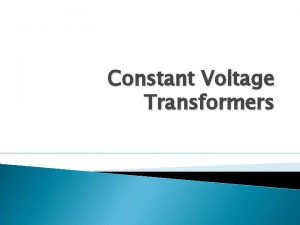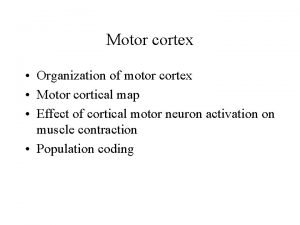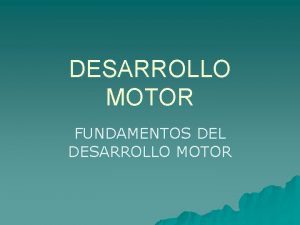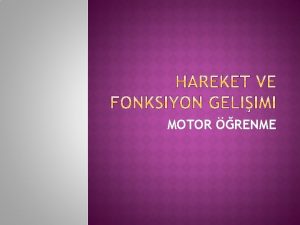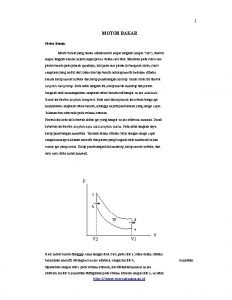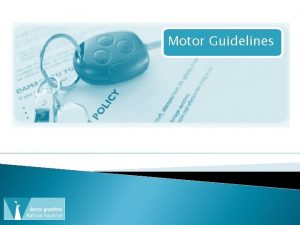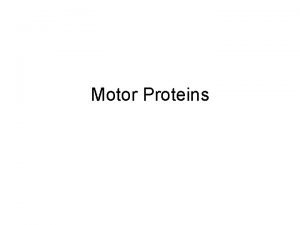Maximizing Motor Power at Constant Voltage Principles of















- Slides: 15

Maximizing Motor Power at Constant Voltage Principles of Engineering © 2012 Project Lead The Way, Inc.

Speed Depends on Load Torque When a motor is loaded with no torque, it spins at no-load speed, w 0 = no-load speed When a motor is loaded with the stall torque tstall or more, the motor will stop. tstall = stall torque

Speed w Speed vs. Torque is Linear w 0 No-load speed Half speed Stall tstall Torque t

Speed w Optional slide for the genius: Speed vs. Torque Depends on Voltage 7 V m 5 ot V 3 V m m or ot ot or s pe sp ee d pe e ed 9 0 d 60 1 2 Torque t 0

Power = Torque x Angular Speed P = t • w

Speed w Power = Torque x Speed w 0 No power. Why? tstall Torque t

Speed w Maximum Power at Half Stall Torque w 0 Maximum power. Why? Torque t tstall

Why half stall torque? Linear equation from last slide. Multiply both sides by torque, product on left is power. Down-facing parabola.

Maximum Power at Half Stall Torque Power P Maximum power Stall No load Torque t

VEX® Application: Pick a Gear Ratio Step 1. This motor is stalled. What is the stall torque? = (3 in. )(1. 4 lb) = 4. 2 lb·in. VEX motor F = 1. 4 lb tstall = d x F┴ d = 3 in. Step 2. At what torque will the motor deliver maximum power? tmax. Power = ½ tstall = ½ (4. 2 lb·in. ) = 2. 1 lb·in.

VEX Application: Pick a Gear Ratio Step 3. The same motor as in the last slide is being used to power a winch with a drum of radius 2 in. lifting 0. 2 lb. What torque is the motor applying? d= tout = d x F┴ n. F = 0. 2 lbs 2 i = (2 in. )(0. 2 lb) = 0. 4 lb·in.

VEX Application: Pick a Gear Ratio Step 4. Instead of direct drive, what gear ratio would make the motor deliver maximum power? d= GR = n. F = 0. 2 lbs 2 i

VEX Application: Pick a Gear Ratio Now the winch is geared so that the motor is delivering half its stall torque, for maximum power. GR =

Human Application: Bicycle “gears” Can you explain why changing “gears” on a bike helps a person win a race that goes up and down hills?

References Micromo (n. d. ). DC Motors Tutorials. Retrieved from http: //www. micromo. com/dc-motor-tutorials. aspx MIT Center for Innovation in Product Development (1999). Designing with DC Motors. Retrieved from http: //lancet. mit. edu/motors/index. html Wikipedia (2009). Derailleur Bicycle Drivetrain. Retrieved from http: //en. wikipedia. org/wiki/File: Derailleur_Bicycle_Drivet rain. svg
 Motor power constant
Motor power constant Voltage level
Voltage level Application of ac voltage controller
Application of ac voltage controller Difference between phase voltage and line voltage
Difference between phase voltage and line voltage How to convert peak voltage to rms
How to convert peak voltage to rms Objective of earthing or grounding is
Objective of earthing or grounding is Passive sign convention
Passive sign convention Line regulation formula
Line regulation formula Induction motor voltage equation
Induction motor voltage equation Motor voltage equation
Motor voltage equation Stator voltage control of induction motor
Stator voltage control of induction motor Triangle of power
Triangle of power Constant pointer and pointer to constant
Constant pointer and pointer to constant üyou
üyou Constant pointer and pointer to constant
Constant pointer and pointer to constant Formation constant vs equilibrium constant
Formation constant vs equilibrium constant






